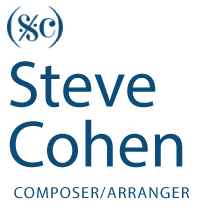Saxophone Quartet No. 2
Year: 1998
Duration: 23:00
Personnel: Saxophone Quartet (SATB)
Premiered 30 November 1998
Manhattan School of Music
Surge Saxophone Quartet
Reviews:
The New Hudson Saxophone Quartet arrived on stage. Saxophone Quartet #2 (1988) is perhaps New York contemporary composer Steve Cohen’s (b.1954) most famous composition. It has the density and finesse of a classical string quartet. The mellifluous opening Andante proposed a unified yet complex musical discussion; the following Scherzo was replete with upper and lower register jokes between Cohen on soprano sax and Tim Ruedeman on baritone sax; the movement sounded like a comic sax traffic jam; the Adagio delivered lyric nuance with great unity, Cohen’s soprano sax soaring with excellent support from Bence Szepesi on alto sax; the concluding Allegro Giocoso centered on Brellochs’ tenor sax taking the lead and the other sax players agreeably following. There was drama, humor, and offbeat lyricism in this sophisticated quartet.
— Kent T. McEneaney, The Millbrook Independent: 14 September 2019
http://www.themillbrookindependent.com/content/brellochs-company-vassar#disqus_thread
Recommended for high school and college quartets, or professional groups.
— Saxophone Journal Volume 30, Number 3 Jan/Feb 2006
This 1998 quartet, by New York composer Steve Cohen, is recently published. It represents a beautiful example of contemporary neo-classical writing. Perhaps the best statement that can be made about the piece is that its musicality transcends the realm of the saxophone. Audiences who may be new to the concept of classical saxophone will be very moved by this piece’s lyricism, counterpoint, melodic interest and interplay.
Each of the four parts lays well on the instrument, and the music is beautifully engraved and easy to read. None of the parts are technically difficult, with no extended range issues or nasty technical passages. A good high school or college player could handle the technical challenges. That said, it takes a considerable amount of musicianship, thought, and group rehearsal to make this piece sing, as demanded by the lyrical melodic elements of this quartet, and the way the voices mesh (sometimes with lightning precision).
The first movement has the effect of an introduction, creating a flowing, pastoral atmosphere that opens with unaccompanied tenor, soon joined by all voices in some wonderful modulations and mode changes.
The second movement is a scherzo that features some interlocking acrobatics and great compositional effects that show off the saxophone’s agility. The composer’s notes mention the created illusion of circular breathing among the group, and a more percussive nature.
The third movement, an adagio, has the piece’s most lyrical moments, interspersed with jazz-like clusters in the ensemble.
The allegro giocoso finale is the most neoclassical of the four movements, and sets a playful mood with an ascending scale motive that is soon broken up and quickly passed around in fugue-like environments. This movement ties up the entire work by bringing in elements of the other three movements, cast as the half tempo pastoral melodic basis of bubbling melodic comments from solo parts.
This SATB quartet is a gem, and its approach is shared by only a handful of other new compositions. It would be a beautiful addition to any professional quartet’s repertoire, and will teach any student group a great deal about the chamber music tradition.
— David Demsey

